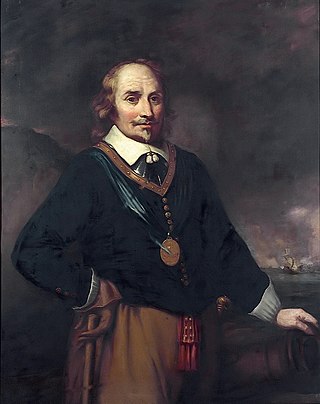
Maarten Harpertszoon Tromp or Maarten van Tromp was an army general and admiral in the Dutch navy during much of the Eighty Years' War and throughout the First Anglo-Dutch War. Son of a ship's captain, Tromp spent much of his childhood at sea, during which time he was captured by pirates and enslaved by Barbary Corsairs. In adult life, he became a renowned ship captain and naval commander, successfully leading Dutch forces fighting for independence in the Eighty Years War, and then against England in the First Anglo-Dutch War, proving an innovative tactician and enabling the newly independent Dutch nation to become a major sea power. He was killed in battle by a sharpshooter from an English ship. Several ships of the Royal Netherlands Navy have carried the name HNLMS Tromp after him and/or his son Cornelis, also a Dutch Admiral of some renown.

The Second Anglo-Dutch War, or Second Dutch War, began on 4 March 1665, and concluded with the signing of the Treaty of Breda on 31 July 1667. One in a series of naval conflicts between England and the Dutch Republic, its causes were a combination of political differences and commercial disputes.
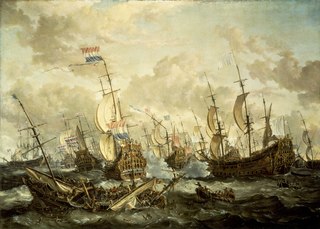
The Four Days' Battle was a naval engagement fought from 11 to 14 June 1666 during the Second Anglo-Dutch War. It began off the Flemish coast and ended near the English coast, and remains one of the longest naval battles in history.

Michiel Adriaenszoon de Ruyter was a Dutch admiral. His achievements with the Dutch Navy during the Anglo-Dutch Wars earned him the reputation as one of the most skilled naval commanders in history.

The Battle of the Gabbard, was a naval battle fought from 2 to 3 June 1653 during the First Anglo-Dutch War. It took place near the Gabbard shoal off the coast of Suffolk, England, between fleets of the Commonwealth of England and the Dutch Republic. It resulted in a decisive English victory.

The Battle of Ushant took place on 27 July 1778, and was fought during the American Revolutionary War between French and British fleets 100 miles (160 km) west of Ushant, an island at the mouth of the English Channel off the westernmost point of France. "Ushant" is the anglicised pronunciation of "Ouessant".

Jacob, Banner Lord of Wassenaer, Lord Obdam, Hensbroek, Spanbroek, Opmeer, Zuidwijk and Kernhem was a Dutch nobleman who became lieutenant admiral, and supreme commander of the navy of the Dutch Republic. The name Obdam was then also spelled as Opdam. British contemporaneous sources typically refer to him as Admiral Opdam or Lord Obdam because it was not until 1657 that he bought the Wassenaar Estate from relatives and thus acquired its title. Modern Dutch sources sometimes less correctly insert a second "van" between "Wassenaer" and "Obdam" or use the modern spelling "Wassenaar".

The Battle of Dogger Bank was a naval battle that took place on 5 August 1781 during the Fourth Anglo-Dutch War, contemporaneously related to the American Revolutionary War, in the North Sea. It was a bloody encounter between a British squadron under Vice Admiral Sir Hyde Parker and a Dutch squadron under Vice Admiral Johan Zoutman, both of which were escorting convoys.

The St James' Day Battle took place on 25 July 1666, during the Second Anglo-Dutch War. It was fought between an English fleet commanded jointly by Prince Rupert of the Rhine and George Monck, and a Dutch force under Lieutenant-Admiral Michiel de Ruyter.

HMS Dartmouth was a small frigate or fifth-rate ship, one of six ordered by the English Council of State on 28 December 1654, and built in 1655.
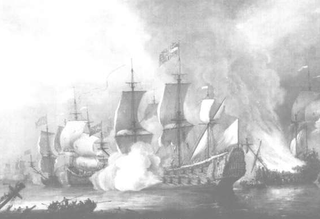
The Battle of Bantry Bay was a naval engagement fought on 11 May 1689, a week before the declaration of the Nine Years' War. The English fleet was commanded by Admiral Arthur Herbert, created Earl of Torrington after the Battle; the French fleet by François Louis de Rousselet, Marquis de Châteaurenault. Apart from the inshore operations at La Rochelle in 1627–28, the Battle of Bantry Bay was the first time English and French navies had met in fleet action since 1545.

Victory was a great ship of the English Navy, launched in 1620 and in active service during the seventeenth century's Anglo-Dutch Wars. After a seventy-year naval career, she was broken up at Woolwich Dockyard in 1691 and her timbers reused in other vessels.
Sapphire was a 38-gun fourth-rate of the Commonwealth of England. After commissioning she was actively involved in the First Anglo-Dutch War participating in most major fleet actions. During the Second Anglo-Dutch War she was only in the first two engagements then spent her time in Irish Waters and the Mediterranean. She was run ashore due to a pending attack by suspected Algerian pirates on Sicily in March 1670.
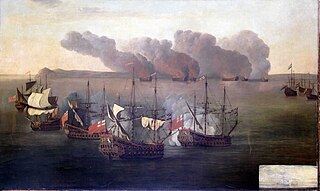
Foresight was a 40-gun fourth-rate of the Commonwealth of England, after the Restoration of the monarchy in 1660 she was incorporated into the Navy of the Kingdom of England. During her time in the Commonwealth Navy she partook in the First Anglo-Dutch war being present in the battles of Dungeness, Kentish Knock, Portland, The Gabbard and Scheveningen. She was also present at the Battle of Santa Cruz and the bombardment of Porto Farina, In the Second Anglo-Dutch War she was involved in the Battle of Vagen and the St James Day Fight. During the Third Anglo-Dutch War she participated in the battles of Schooneveld and Texel. For the remainder of her career she was in the West Indies, the Mediterranean and North American waters. She was wrecked south of Cuba in July 1698.
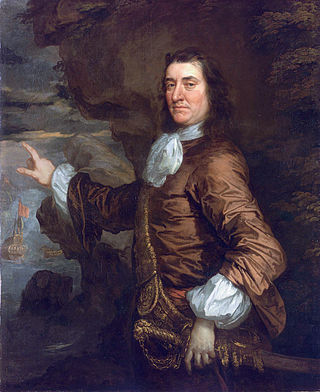
Admiral Sir Thomas Allin, 1st Baronet (1612–1685) was an officer of the Royal Navy who saw service in the English Civil War, and the Second and Third Anglo-Dutch Wars. A Royalist during the Civil War, he returned to service after the Restoration and eventually rose to the rank of Admiral of the White after serving under some of the most distinguished military figures of the era, including Prince Rupert of the Rhine.

The action of 13 October 1796 was a minor naval engagement of the French Revolutionary Wars, fought off the Mediterranean coast of Spain near Cartagena between the British Royal Navy 32-gun frigate HMS Terpsichore under Captain Richard Bowen and the Spanish Navy 34-gun frigate Mahonesa under Captain Tomás de Ayalde. The action was the first battle of the Anglo-Spanish War, coming just eight days after the Spanish declaration of war. In a battle lasting an hour and forty minutes, Mahonesa was captured.

Sir Jeremiah Smith was an officer of the Royal Navy who saw service during the First and Second Anglo-Dutch Wars, rising to the rank of admiral.
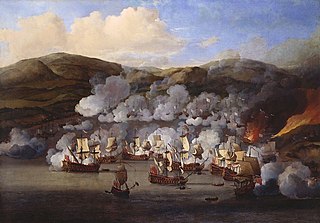
The Battle of Martinique took place off the Caribbean island of Martinique from 30 June to 7 July 1667, towards the end of the Second Anglo-Dutch War. A French fleet commanded by de la Barre was virtually destroyed by a Royal Navy squadron under Sir John Harman. Victory meant the English restored their position in the region shortly before the Treaty of Breda ended the war on 31 July 1667.

Admiral Sir John Harman was an English officer of the Royal Navy, who served first under the Commonwealth, then Charles II following the 1660 Stuart Restoration.

Rear-Admiral Sir Thomas Hardy was a Royal Navy officer of the late 17th and early 18th centuries. Having joined the navy sometime before 1688, Hardy's career was supported by Captain George Churchill, whom he served as first lieutenant during the Battle of Barfleur in 1692. Promoted to captain in 1693, Hardy served in the Channel Islands and off the coast of England until 1702 when he was given command of HMS Pembroke off the coast of Spain. He fought at the Battle of Cádiz, and subsequently discovered the location of the Franco-Spanish fleet through the intervention of his chaplain, which resulted in the Battle of Vigo Bay. Hardy was knighted for his services.


















